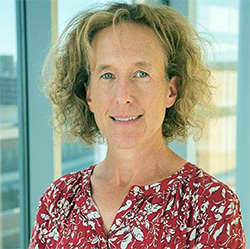Metabolic Bone Disease
Clinical Highlights
Metabolic bone disorders are conditions that result in fractures or deformity of bones due to abnormal bone remodeling. The most common metabolic bone disease we see is osteoporosis. We also provide care for patients with parathyroid disease, Paget's disease, hypophosphatemic disorders, hypophosphatasia, osteogenesis imperfecta and other rare bone disorders.
Services offered
Our program is unique in that our bone densitometry (Dual Energy X-ray absorptiometry or DXA) program and reading of bone density are shared between endocrinology and radiology.
We partner closely with our colleagues in multiple departments:
- Orthopedic Surgery to care for patients undergoing bone and joint procedures,
- Sports Medicine to evaluate athletes with low bone density and/or fractures and a joint clinic with musculoskeletal radiology where we ensure patients who are referred for kyphoplasty for vertebral compression fractures undergo work up and treatment for osteoporosis.
- Our Endocrine Surgery colleagues to provide expertise for patients with parathyroid disorders who seek surgical consultation.
- We have helped to develop a Fracture Liaison Service with partners in Ambulatory Health Promotion as well as post hip fracture order sets with Orthopedic Surgery and Hospital Medicine to ensure adequate treatment for osteoporosis after hip fracture and other low trauma fractures.
- We have several multidisciplinary clinics where we offer services in conjunction with Rheumatology and Musculoskeletal Radiology.
Contact Us
Email Our Director: Micol Rothman MD
So many times when a low trauma fracture occurs, the underlying osteoporosis gets lost in the shuffle. Our goal is to provide evaluation and treatment in a partnership with our patients to help them make informed choices about osteoporosis.

Micol Rothman
MD, Professor of MedicineOur Providers
Testimonials
The initiative to expand research in the Department of Orthopedics was driven by the vision of Dr. Bob D’Ambrosia and Dr. Evalina Burger and pivoted from the rich environment at the 4 CU campuses that include leading researchers in the bone and cartilage biology and skeletal tissue engineering fields. This was a main draw for six new faculty to join over the past 2 years, including Drs. Cheryl Ackert-Bicknell, Doug Adams, Vanessa Sherk, Sri Iyer, Larry Moreland and Mike Zuscik.
Mike Zuscik
PhD, Mack Clayton Professor, Department of OrthopedicsMy interest in metabolic bone disease stems from the patients that we treat. A multi-disciplinary approach is necessary to optimize their overall bone health to keep them out of the hospital, allowing them to continue their usual activities.
Corey Ho
MD, Assistant Professor of Radiology